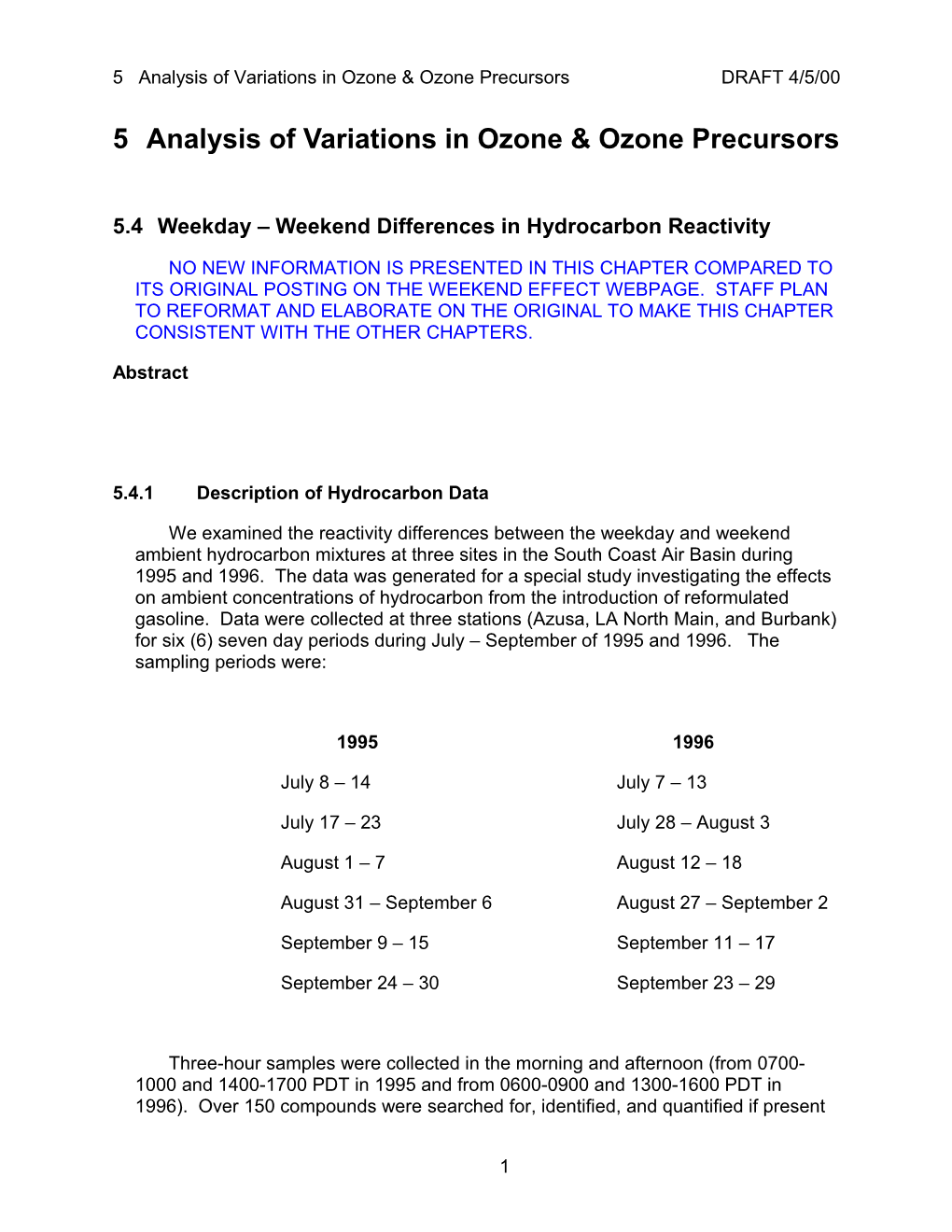5 Analysis of Variations in Ozone & Ozone PrecursorsDRAFT 4/5/00
5Analysis of Variations in Ozone & Ozone Precursors
5.4Weekday – Weekend Differences in Hydrocarbon Reactivity
NO NEW INFORMATION IS PRESENTED IN THIS CHAPTER COMPARED TO ITS ORIGINAL POSTING ON THE WEEKEND EFFECT WEBPAGE. STAFF PLAN TO REFORMAT AND ELABORATE ON THE ORIGINAL TO MAKE THIS CHAPTER CONSISTENT WITH THE OTHER CHAPTERS.
Abstract
5.4.1Description of Hydrocarbon Data
We examined the reactivity differences between the weekday and weekend ambient hydrocarbon mixtures at three sites in the South Coast Air Basin during 1995 and 1996. The data was generated for a special study investigating the effects on ambient concentrations of hydrocarbon from the introduction of reformulated gasoline. Data were collected at three stations (Azusa, LA North Main, and Burbank) for six (6) seven day periods during July – September of 1995 and 1996. The sampling periods were:
19951996
July 8 – 14 July 7 – 13
July 17 – 23July 28 – August 3
August 1 – 7August 12 – 18
August 31 – September 6August 27 – September 2
September 9 – 15 September 11 – 17
September 24 – 30 September 23 – 29
Three-hour samples were collected in the morning and afternoon (from 0700-1000 and 1400-1700 PDT in 1995 and from 0600-0900 and 1300-1600 PDT in 1996). Over 150 compounds were searched for, identified, and quantified if present in the sample. For this analysis all identified hydrocarbons ranging from carbon number C2 to C12 were included, as well as the oxygenated hydrocarbons MTBE, formaldehyde and acetaldehyde. The average morning and afternoon weight fraction of each hydrocarbon species for the weekday (Monday through Friday) and the weekend (Saturday and Sunday) was multiplied by its MIR (Maximum Incremental Reactivity value) and summed to give the total reactivity of the normalized (per gram of hydrocarbon mixture) weekday and weekend hydrocarbon ambient mixture. Approximately 30 weekday samples and 12 weekend samples were averaged for the morning and afternoon sampling periods respectively for each year.
5.4.2Conclusions
The results for both 1995 and 1996 are shown in Figures 1 and 2 respectively. From these figures several preliminary conclusions can be determined:
1)The reactivity of the ambient hydrocarbon mixture has dropped between 1995 and 1996.
2)Weekend reactivity appears slightly lower on the weekends.
3)Differences in weekday and weekend reactivity seem greatest for the afternoon samples.
5.4.3Recommendations
1)Perform statistical analysis to determine if the differences outlined above are significant.
2)Perform similar analysis with routinely collected PAMS data.
3)Determine if improved hydrocarbon measurements are needed.
Figure 5.4-1. 1995 Weekday/Weekend reactivity comparison.
Figure 5.4-2. 1996 Weekday/Weekend reactivity comparison.
1
